Mandy Guo
Imagen 3
Aug 13, 2024Abstract:We introduce Imagen 3, a latent diffusion model that generates high quality images from text prompts. We describe our quality and responsibility evaluations. Imagen 3 is preferred over other state-of-the-art (SOTA) models at the time of evaluation. In addition, we discuss issues around safety and representation, as well as methods we used to minimize the potential harm of our models.
Greedy Growing Enables High-Resolution Pixel-Based Diffusion Models
May 27, 2024



Abstract:We address the long-standing problem of how to learn effective pixel-based image diffusion models at scale, introducing a remarkably simple greedy growing method for stable training of large-scale, high-resolution models. without the needs for cascaded super-resolution components. The key insight stems from careful pre-training of core components, namely, those responsible for text-to-image alignment {\it vs.} high-resolution rendering. We first demonstrate the benefits of scaling a {\it Shallow UNet}, with no down(up)-sampling enc(dec)oder. Scaling its deep core layers is shown to improve alignment, object structure, and composition. Building on this core model, we propose a greedy algorithm that grows the architecture into high-resolution end-to-end models, while preserving the integrity of the pre-trained representation, stabilizing training, and reducing the need for large high-resolution datasets. This enables a single stage model capable of generating high-resolution images without the need of a super-resolution cascade. Our key results rely on public datasets and show that we are able to train non-cascaded models up to 8B parameters with no further regularization schemes. Vermeer, our full pipeline model trained with internal datasets to produce 1024x1024 images, without cascades, is preferred by 44.0% vs. 21.4% human evaluators over SDXL.
Gemini: A Family of Highly Capable Multimodal Models
Dec 19, 2023Abstract:This report introduces a new family of multimodal models, Gemini, that exhibit remarkable capabilities across image, audio, video, and text understanding. The Gemini family consists of Ultra, Pro, and Nano sizes, suitable for applications ranging from complex reasoning tasks to on-device memory-constrained use-cases. Evaluation on a broad range of benchmarks shows that our most-capable Gemini Ultra model advances the state of the art in 30 of 32 of these benchmarks - notably being the first model to achieve human-expert performance on the well-studied exam benchmark MMLU, and improving the state of the art in every one of the 20 multimodal benchmarks we examined. We believe that the new capabilities of Gemini models in cross-modal reasoning and language understanding will enable a wide variety of use cases and we discuss our approach toward deploying them responsibly to users.
mLongT5: A Multilingual and Efficient Text-To-Text Transformer for Longer Sequences
May 18, 2023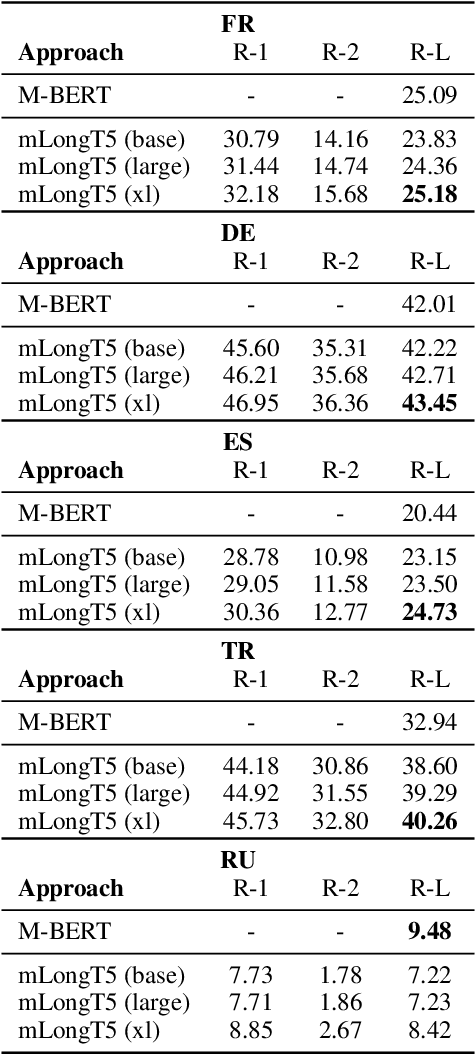


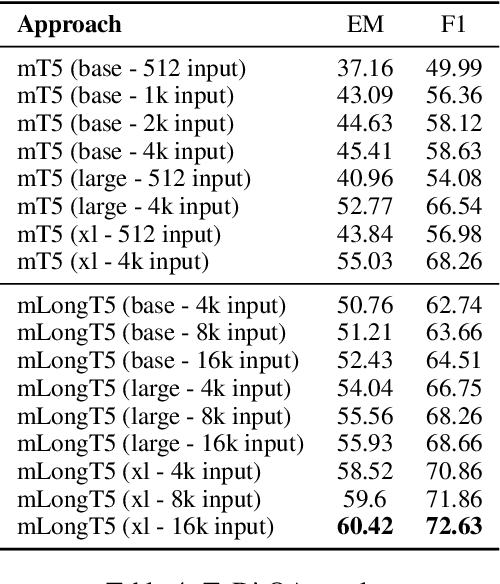
Abstract:We present our work on developing a multilingual, efficient text-to-text transformer that is suitable for handling long inputs. This model, called mLongT5, builds upon the architecture of LongT5, while leveraging the multilingual datasets used for pretraining mT5 and the pretraining tasks of UL2. We evaluate this model on a variety of multilingual summarization and question-answering tasks, and the results show stronger performance for mLongT5 when compared to existing multilingual models such as mBART or M-BERT.
WikiWeb2M: A Page-Level Multimodal Wikipedia Dataset
May 09, 2023


Abstract:Webpages have been a rich resource for language and vision-language tasks. Yet only pieces of webpages are kept: image-caption pairs, long text articles, or raw HTML, never all in one place. Webpage tasks have resultingly received little attention and structured image-text data underused. To study multimodal webpage understanding, we introduce the Wikipedia Webpage 2M (WikiWeb2M) suite; the first to retain the full set of images, text, and structure data available in a page. WikiWeb2M can be used for tasks like page description generation, section summarization, and contextual image captioning.
A Suite of Generative Tasks for Multi-Level Multimodal Webpage Understanding
May 05, 2023Abstract:Webpages have been a rich, scalable resource for vision-language and language only tasks. Yet only pieces of webpages are kept: image-caption pairs, long text articles, or raw HTML, never all in one place. Webpage tasks have resultingly received little attention and structured image-text data left underused. To study multimodal webpage understanding, we introduce the Wikipedia Webpage suite (WikiWeb2M) of 2M pages. We verify its utility on three generative tasks: page description generation, section summarization, and contextual image captioning. We design a novel attention mechanism Prefix Global, which selects the most relevant image and text content as global tokens to attend to the rest of the webpage for context. By using page structure to separate such tokens, it performs better than full attention with lower computational complexity. Experiments show that the new annotations from WikiWeb2M improve task performance compared to data from prior work. We also include ablations on sequence length, input features, and model size.
CoBIT: A Contrastive Bi-directional Image-Text Generation Model
Mar 23, 2023
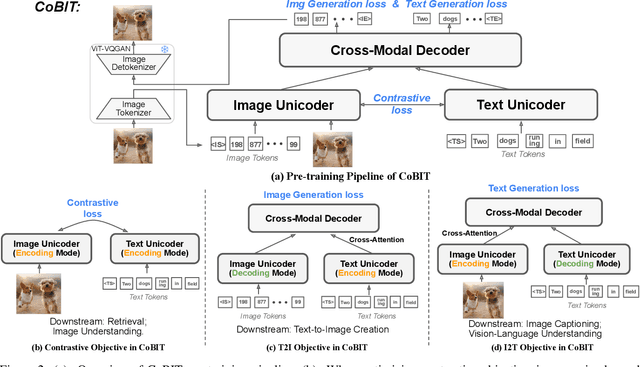
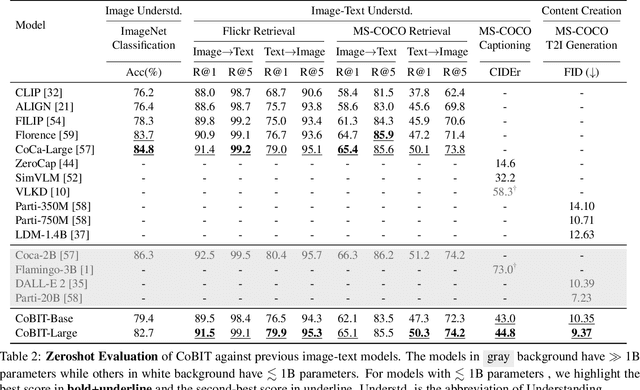
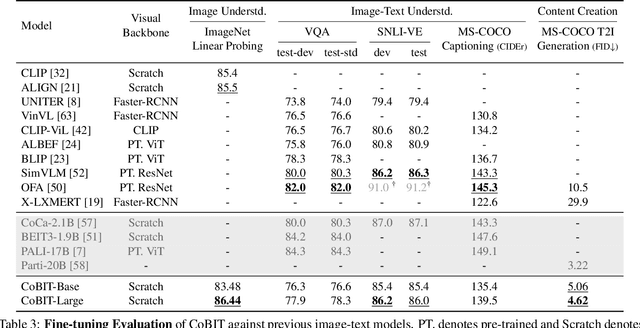
Abstract:The field of vision and language has witnessed a proliferation of pre-trained foundation models. Most existing methods are independently pre-trained with contrastive objective like CLIP, image-to-text generative objective like PaLI, or text-to-image generative objective like Parti. However, the three objectives can be pre-trained on the same data, image-text pairs, and intuitively they complement each other as contrasting provides global alignment capacity and generation grants fine-grained understanding. In this work, we present a Contrastive Bi-directional Image-Text generation model (CoBIT), which attempts to unify the three pre-training objectives in one framework. Specifically, CoBIT employs a novel unicoder-decoder structure, consisting of an image unicoder, a text unicoder and a cross-modal decoder. The image/text unicoders can switch between encoding and decoding in different tasks, enabling flexibility and shared knowledge that benefits both image-to-text and text-to-image generations. CoBIT achieves superior performance in image understanding, image-text understanding (Retrieval, Captioning, VQA, SNLI-VE) and text-based content creation, particularly in zero-shot scenarios. For instance, 82.7% in zero-shot ImageNet classification, 9.37 FID score in zero-shot text-to-image generation and 44.8 CIDEr in zero-shot captioning.
CoLT5: Faster Long-Range Transformers with Conditional Computation
Mar 17, 2023Abstract:Many natural language processing tasks benefit from long inputs, but processing long documents with Transformers is expensive -- not only due to quadratic attention complexity but also from applying feedforward and projection layers to every token. However, not all tokens are equally important, especially for longer documents. We propose CoLT5, a long-input Transformer model that builds on this intuition by employing conditional computation, devoting more resources to important tokens in both feedforward and attention layers. We show that CoLT5 achieves stronger performance than LongT5 with much faster training and inference, achieving SOTA on the long-input SCROLLS benchmark. Moreover, CoLT5 can effectively and tractably make use of extremely long inputs, showing strong gains up to 64k input length.
LongT5: Efficient Text-To-Text Transformer for Long Sequences
Dec 15, 2021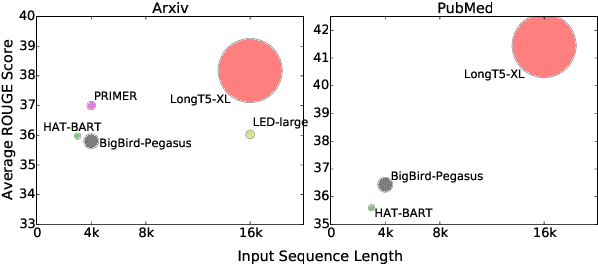

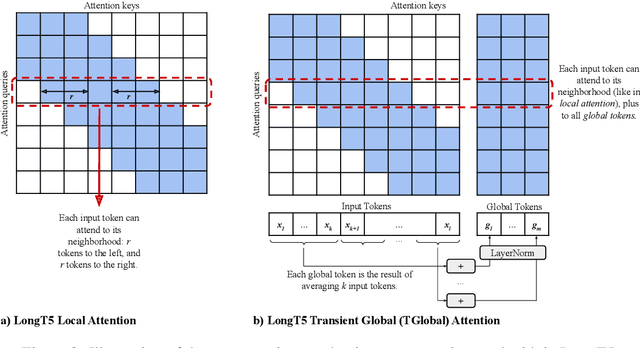
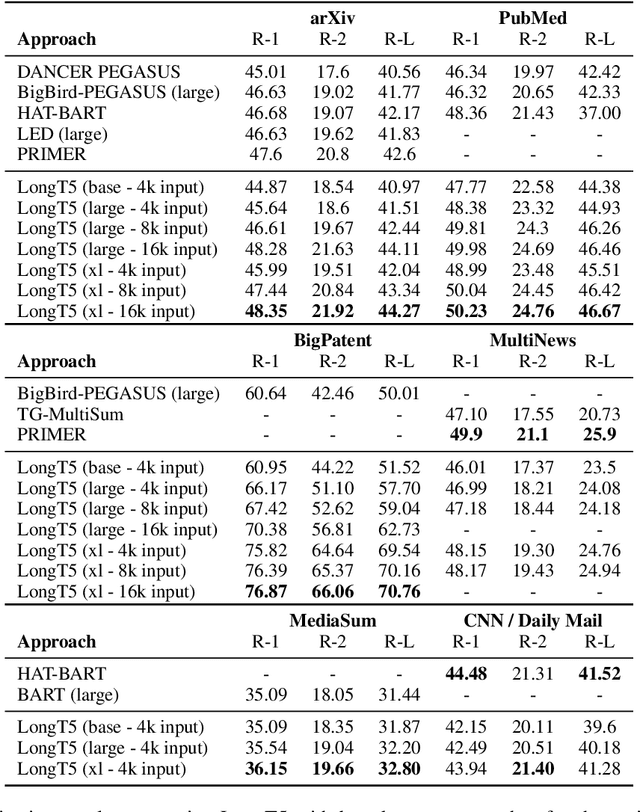
Abstract:Recent work has shown that either (1) increasing the input length or (2) increasing model size can improve the performance of Transformer-based neural models. In this paper, we present a new model, called LongT5, with which we explore the effects of scaling both the input length and model size at the same time. Specifically, we integrated attention ideas from long-input transformers (ETC), and adopted pre-training strategies from summarization pre-training (PEGASUS) into the scalable T5 architecture. The result is a new attention mechanism we call {\em Transient Global} (TGlobal), which mimics ETC's local/global attention mechanism, but without requiring additional side-inputs. We are able to achieve state-of-the-art results on several summarization tasks and outperform the original T5 models on question answering tasks.
MURAL: Multimodal, Multitask Retrieval Across Languages
Sep 10, 2021



Abstract:Both image-caption pairs and translation pairs provide the means to learn deep representations of and connections between languages. We use both types of pairs in MURAL (MUltimodal, MUltitask Representations Across Languages), a dual encoder that solves two tasks: 1) image-text matching and 2) translation pair matching. By incorporating billions of translation pairs, MURAL extends ALIGN (Jia et al. PMLR'21)--a state-of-the-art dual encoder learned from 1.8 billion noisy image-text pairs. When using the same encoders, MURAL's performance matches or exceeds ALIGN's cross-modal retrieval performance on well-resourced languages across several datasets. More importantly, it considerably improves performance on under-resourced languages, showing that text-text learning can overcome a paucity of image-caption examples for these languages. On the Wikipedia Image-Text dataset, for example, MURAL-base improves zero-shot mean recall by 8.1% on average for eight under-resourced languages and by 6.8% on average when fine-tuning. We additionally show that MURAL's text representations cluster not only with respect to genealogical connections but also based on areal linguistics, such as the Balkan Sprachbund.
 Add to Chrome
Add to Chrome Add to Firefox
Add to Firefox Add to Edge
Add to Edge